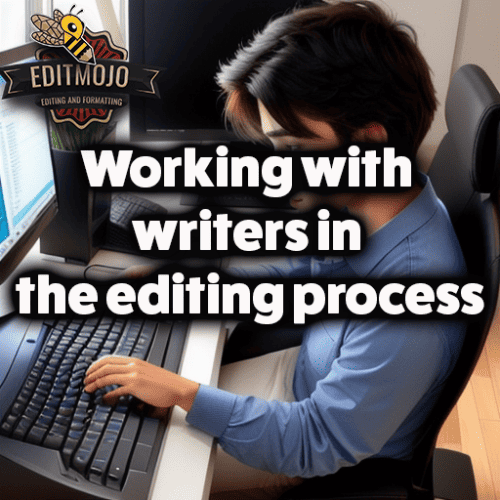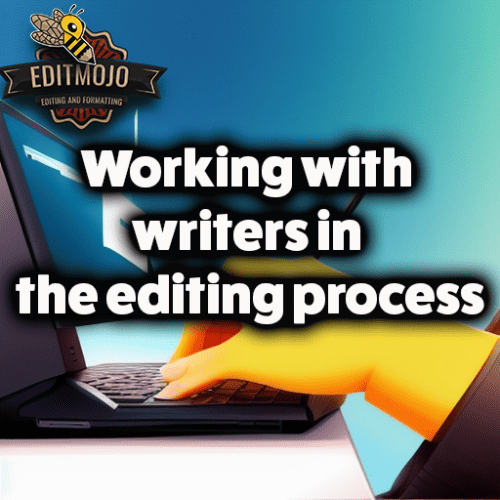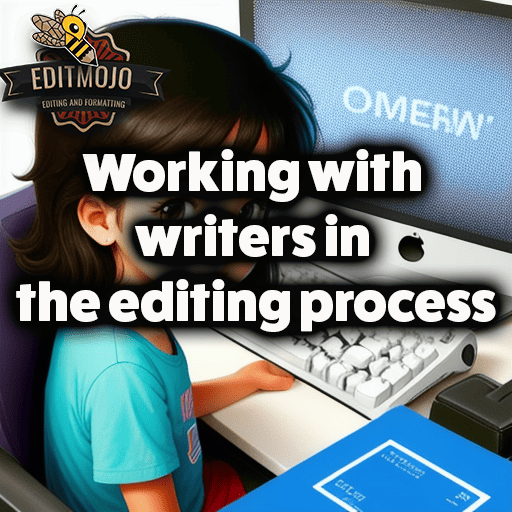Working with writers in the editing process
Working with writers in the editing process. As the saying goes, “Writing is rewriting.” But, it’s also about refining, revising, and rejuvenating the initial draft. An essential part of this process involves collaboration between the writer and the editor. This crucial relationship forms the core of a manuscript’s journey from draft to publication. However, to ensure a successful outcome, both parties must navigate this relationship with care, understanding, and mutual respect.
Key Takeaways
| Topic | Takeaway |
|---|---|
| Writer’s Role | The writer’s job is to engage the audience with creativity and a unique voice. They can often feel vulnerable about their work. |
| Editor’s Role | Editors enhance the manuscript’s quality while preserving the writer’s voice. They aim to refine, not rewrite. |
| Editing Process | Editing is a multi-stage journey, requiring open dialogue and collaboration at each step. |
| Communication | Trust, common language, and constructive feedback are crucial for effective communication between a writer and editor. |
| Preserving Voice | An editor must enhance clarity and effectiveness without diluting the writer’s unique voice. |
| Conflict Resolution | Conflicts can be resolved through open communication, mediation, and distinguishing between objective and subjective issues. |
| Successful Collaborations | Successful writer-editor relationships lead to enhanced creative output, skill improvement, and a smoother editing process. |
II. Understanding the Roles and Perspectives
A. The Role of a Writer
A writer isn’t just someone who puts words on a page. They are world-creators, thought-weavers, and emotion-evokers. Their primary role is to captivate the audience with their ideas, creativity, and unique voice. They have to strike a delicate balance between portraying a story’s overarching theme and maintaining the reader’s engagement throughout.
It’s also important to remember that writers, like all creatives, can often feel a sense of vulnerability regarding their work. It’s not just words on paper, but a reflection of their thoughts and a product of their imagination. As renowned writer Margaret Atwood once said, “Wanting to meet an author because you like his work is like wanting to meet a duck because you like pâté.”

B. The Role of an Editor
Editors are the unsung heroes of the publishing world. They are tasked with the responsibility of enhancing the manuscript’s overall quality. Different types of editors have specific roles—developmental editors look at the big picture, while copy editors focus on details like grammar and punctuation. They work diligently to ensure that the manuscript is coherent, engaging, and free from errors.
However, the most important part of an editor’s job is to do all this while preserving the writer’s unique voice. Their role is not to rewrite but to refine.
III. The Editing Process: A Two-Way Street
A. Stages of the Editing Process
Editing is not a one-size-fits-all process. It’s a journey with different stages, each addressing specific elements of the manuscript:
- Developmental Editing: This stage focuses on the overall structure, flow, and content of the story. It’s about ensuring the plot makes sense, the characters are well developed, and the pacing is just right.
- Line Editing: Line editing is all about refining each line for maximum impact. This involves improving sentence structure, eliminating redundancy, and enhancing readability.
- Copy Editing: Copy editors correct grammar, punctuation, and spelling errors. They also ensure consistency in terminology, voice, and style.
- Proofreading: The final stage of editing, where minute errors that might have been missed during copy editing are corrected.
B. The Collaborative Nature of Each Stage
Each of these stages requires an open dialogue between the writer and the editor. It’s about understanding and respecting each other’s viewpoints and working together to make the manuscript the best it can be. As F. Scott Fitzgerald once said, “Write drunk, edit sober.” This not only highlights the level of scrutiny required in editing but also reflects on the need for a sober, balanced interaction between the two parties involved.
IV. Communication: The Bedrock of Successful Editing
A. Effective Communication Strategies
Communication is the heartbeat of the writer-editor relationship. Here are some key strategies:
- Building Trust and Setting Expectations: The editor needs to establish a relationship based on trust, assuring the writer that they are working together to improve the manuscript and not to criticize or undermine their work.
- Developing a Common Language: This means creating a shared understanding of terminologies and concepts used during the editing process.
- Giving and Receiving Feedback Constructively: Constructive feedback is the key. It should be aimed at improving the work and not be a personal attack on the writer.
B. Case Study: Successful Writer-Editor Collaboration
The collaboration between F. Scott Fitzgerald and his editor, Maxwell Perkins, is a great example of successful writer-editor collaboration. Perkins believed in Fitzgerald’s talent and guided him, providing constructive feedback that allowed Fitzgerald’s unique style to shine through. Their trust and respect for each other allowed them to create works of art that have stood the test of time.

V. Respectful Editing: Preserving the Writer’s Voice
A. The Importance of Respecting the Writer’s Style and Voice
A writer’s voice is their unique literary fingerprint. It’s what sets them apart and makes their work distinctive. An editor’s job is not to change this voice, but to enhance its clarity and effectiveness without diluting its essence. As Zadie Smith, the acclaimed author, said, “The very reason I write is so that I might not sleepwalk through my entire life.” The editor must respect this wakeful, creative state of the writer and tread carefully.
B. The Difference Between Changing and Refining
Changing the style would mean altering the writer’s voice, while refining it means enhancing the original voice’s effectiveness. It’s about making the message more clear and engaging, not changing what the message is.
VI. Conflict Resolution in the Editing Process
A. Common Conflicts
Conflicts can arise due to misunderstandings, differences in viewpoints, or disagreements about style and content. A writer might feel their voice is being stifled, while an editor might feel the writer is not open to necessary changes.
B. Techniques for Resolution
- Addressing Conflicts with Openness and Respect: Both parties should express their concerns openly and honestly, but with respect for the other’s viewpoint.
- Mediation: If the conflict persists, a third party can be brought in to mediate.
- Objective vs Subjective Issues: Distinguishing between objective (factual errors, grammatical mistakes) and subjective (style, tone) issues can help resolve conflicts effectively.
VII. The Benefits of a Positive Writer-Editor Relationship
A positive relationship leads to an enhanced creative output, improved skills for both parties, and a smoother, more enjoyable writing and editing process. It’s a symbiotic relationship that benefits both parties and the final manuscript.

VIII. Case Studies: Successful Writer-Editor Partnerships
Exploring successful collaborations, like that of Stephen King and his editor, Michael Garrett, or Toni Morrison and her editor, Robert Gottlieb, can provide valuable insights and lessons.
IX. Conclusion (Working with writers in the editing process)
The writer-editor relationship is a delicate dance of creativity and technicality, of respect and understanding. A positive collaboration can bring out the best in a manuscript, creating a final product that is engaging, clear, and true to the writer’s unique voice.
X. Additional Resources
For those interested in learning more about this relationship, I recommend books like “The Subversive Copy Editor” by Carol Fisher Saller or “On Writing Well” by William Zinsser. Websites like WritersDigest and The Chicago Manual of Style Online also provide excellent resources.
Top Five Questions and Answers
- What is the role of an editor in the writing process?
An editor enhances the manuscript’s quality by correcting errors, improving structure, and ensuring coherence and engagement, all while preserving the writer’s unique voice. - Why is communication important in the editing process?
Communication forms the backbone of the writer-editor relationship. It helps in building trust, setting expectations, developing a shared language, and giving/receiving feedback constructively. - What is the difference between changing a writer’s style and refining it?
Changing a writer’s style means altering their unique voice, while refining it means enhancing the effectiveness of the original voice without changing its essence. - How can conflicts in the editing process be resolved?
Conflicts can be resolved by addressing concerns with openness and respect, mediation (if necessary), and distinguishing between objective and subjective issues. - What are the benefits of a positive writer-editor relationship?
A positive writer-editor relationship leads to an enhanced creative output, skill improvement for both parties, and a smoother, more enjoyable writing and editing process.
